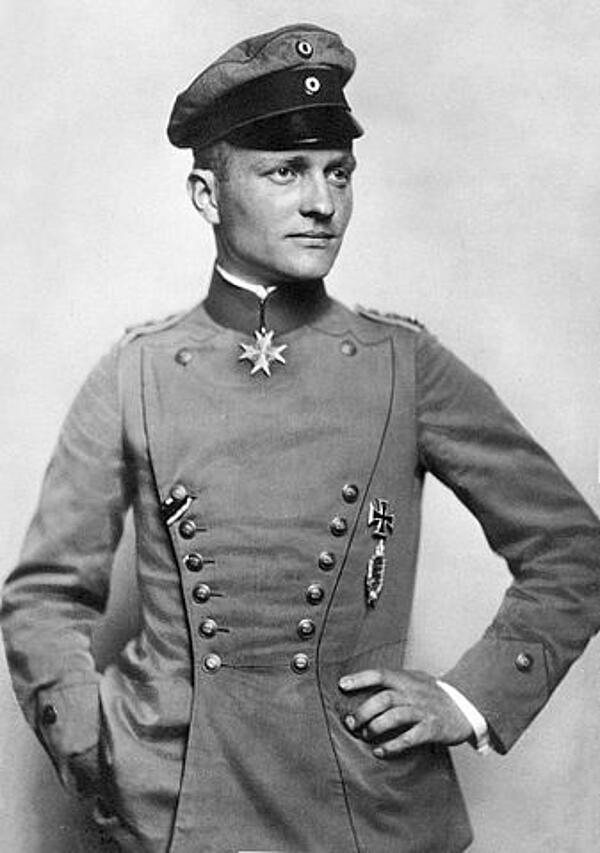Manfred von Richthofen
Manfred von Richthofen was Germany’s most famous flying ace in World War One, nicknamed the ‘Red Baron’. He officially shot down 80 Allied aircraft, which even made him more successful than Allied aces.
Richthofen was born into a Prussian aristocratic family in 1892 and was a ‘Freiherr’, or baron, hence his nickname. Richthofen began cadet training at the age of 11 and then joined the cavalry regiment. When World War One was declared, he was 22 years old and began serving as a cavalry reconnaissance officer.
However, trench warfare made the operation of traditional cavalry regiments almost impossible so he was assigned to the infantry. Richthofen was disappointed by this, wanting to be in action far more than was common for the infantry. As such, he decided to apply to join the Imperial German Army Air Service and joined his new unit in May 1915.
Untrained as a pilot, Richthofen’s was used by his first squadron - No 69 - as an observer on reconnaissance missions on the Eastern Front. However, he was transferred to the Western Front and started training as a pilot in October 1915. He qualified and became active in March 1916, with the first aircraft he flew an Albatros C.III. Sadly, he crashed on his first flight and in the autumn of 1916 he was transferred back to the Eastern Front.
It was here where Richthofen met Oswald Boelcke, a German fighter ace. He was looking for men to join his new squadron - Jagdstaffel 2 - and asked Richthofen to join. This resulted in a transfer back to France; Richthofen made his first kill on 17th September 1916.
Richthofen continued to see success and had a silver cup made by a jeweller in Berlin for every kill he made. However, he only reached 60 before he had to stop due to a silver shortage in Germany.

Despite having a reputation as a daring pilot, Richthofen had actually been taught by Boelcke to avoid taking risks and to be precise when attacking. Typically, this resulted in Richthofen attacking by diving on an aircraft while the sun was behind him, blocking the Allied pilot’s view of his plane.
Although associated with the Fokker Dr.1, Richthofen only flew this aircraft for a short time, with just 19 of his 80 kills attributed to the legendary plane. In fact, he scored most of his kills in amnestying Albatros II or III - the former providing more speed but less agility and the latter providing more agility. It was an Albatros that was first painted red by Richthofen.
In January 1917, after his 16th confirmed kill, Richthofen was awarded the Pour le Mérite (or the ‘Blue Max’), which was, at the time, the highest military honour in Germany. This was the same month he was given command of Jagdstaffel 11 and responsibility for training the pilots who flew in it. It was at this point when he had his Albatros painted red, and he also allowed his pilots to paint their planes as well.
His success with Jagdstaffel 11 became particularly apparent in April 1917 - known as ‘Bloody April’ in the Royal Flying Corps - when he alone shot down 22 aircraft. In June the same year, he was awarded his own wing that comprised of four Jagdstaffels. They were made highly mobile and were expected to operate at any point on the Western Front with minimal notice.
Richthofen was badly injured during an aerial attack on 6th July 1917 and he was unable to fly for four weeks while he recovered. During this time, the government pressured him into writing his autobiography, which was to be used for propaganda purposes and was heavily censored by the authorities to ensure he remained a hero in Germany.
Upon his recover, the was offered a job on the ground but refused as he did not want to be forced to fight wherever required, just as the soldiers. Instead he returned to the air but it was less than a year later when he was killed in combat.
On 21st April 1918, a single 0.303 bullet hit Richthofen. While he managed to land his Fokker Dr.1, albeit in Allied territory, the bullet had done fatal damage to his heart and lungs. He died shortly after being discovered in his aircraft by Australian troops. He was buried with full military honours in the cemetery of the village of Bertangles near Amiens.
Richthofen’s body was moved three times after his initial burial. First, he was moved to Fricourt where the French had created a large military cemetery for the Germans. He was then moved to Germany bu his family in 1925, where he was buried in a war heroes cemetery in the Invalidenfriedhof Cemetery, Berlin. His remains were finally moved in 1975 to his family’s plot.
MLA Citation/Reference
"Manfred von Richthofen". HistoryLearning.com. 2024. Web.
